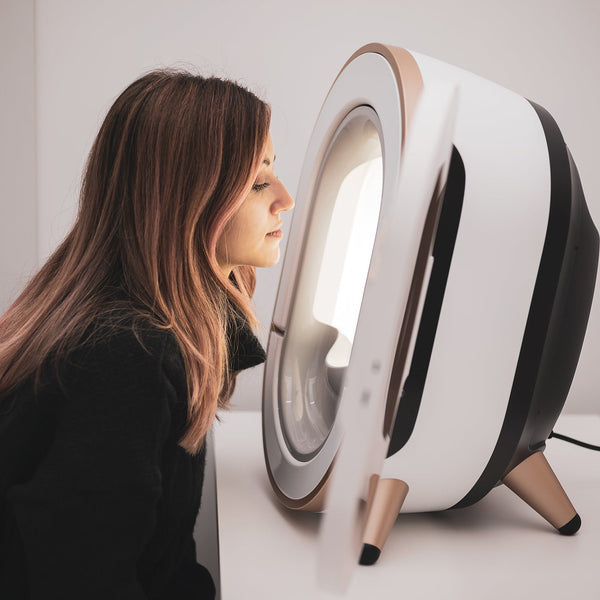Genetic Hyperpigmentation: Spotting Pigmentation Disorders

Hyperpigmentation disorders present as skin that is discolored, blotchy, darker, or lighter than normal – this happens when the body produces too little or too much melanin. These disorders can be localized or can diffusely spread about the entire body. The most common types of genetic hyperpigmentation are birthmarks, macular stains, port wine stains, albinism, piebaldism, and freckles. Not all genetic skin colorations will appear at birth – some, like freckles, appear with sun exposure, while others, like melasma, may appear during pregnancy and in middle-age.
EPHELIDES
Real freckles are commonly found on the skin from an early childhood age. Ephelides are the most common type of freckles – small, pale to dark brown flat marks with a poorly defined border. They are caused by the overproduction of melanin pigment by the melanocytes, which is in direct response to ultraviolet light exposure. People with a variant of a gene called melanocortin-1 get more defined freckles in the summer on sun-exposed areas of the skin. These people tend to have red hair and pale skin and burn more easily and quicker in the sunshine. MC1R controls how much of two different kinds of melanin the skin produces. The two types are darker brown eumelanin and reddish-yellow pheomelanin. If the MC1R gene is inactive, more pheomelanin is produced, leading to light hair and skin, as well as a disposition for freckles. The advice for those with freckled skin is to avoid sunbathing and the use of sun beds, as well as utilize sunscreen both high factor ultraviolet B and ultraviolet A protection.
SOLAR LENTIGINES
As individuals grow older and accumulate more sun exposure, freckles can change to become solar lentigines. These darkened patches result from exposure to ultraviolet radiation, which causes local proliferation of melanocytes and accumulation of melanin within the keratinocytes. Solar lentigines are very common, especially in people over the age of 40 and most commonly present themselves on the face, back of the hands, and the forearms. Avoidance of sunscreen and regular sunburns are the most common cases of solar lentigines. If a client has had a recent sunburn and is concerned whether it may turn into solar lentigo down the road, perform an imaging scan or look at the damaged skin under a Wood’s lamp to access the damage and start treatment.
Although both freckles and solar lentigines are completely benign, it is often difficult to recognize the differences between these and a type of skin cancer called lentigo maligna melanoma. This type of skin cancer also presents as a flat, brown, or black, and irregularly shaped lesion, but it grows very slowly. If a skin care professional notices anything unusual while working on a client, it is best to refer them to a dermatologist for a biopsy.
Multiple lentigines syndrome is also known as L.E.O.P.A.R.D. syndrome, a genetic syndrome transmitted in an autosomal dominant manner that is named for its characteristic features:
L: lentigines on the head and neck
E: electrocardiogram abnormalities
O: ocular hypertelorism (wide-spacing of the eyes)
P: pulmonary stenosis
A: abnormal genitalia
R: retardation of growth
D: deafness
L.E.O.P.A.R.D. syndrome is a rare condition, about 200 patients have been reported worldwide. Within the group of neuro-cardio-facial-cutaneous syndromes, it is the second most common disorder after Noonan syndrome.
MONGOLIAN SPOTS
Mongolian spots, also called blue-gray spots, are large, blue, and flat lesions usually found on the lower back or buttocks of infants at birth. This is the most common type of birthmark, caused by collections of melanocytes located in the dermis. This type of discoloration is harmless and there is no treatment required for Mongolian spots because they naturally fade within the first years of life, typically before the child reaches the age of four.
NEVUS OF OTA
This type of birthmark is marked by bluish or grayish discoloration of the face and sometimes the white part of the eye. The discoloration is caused by increased amounts of the melanin and melanocytes in and around the eyes. People with this type of birthmark are at a higher risk of developing glaucoma, a melanoma cancer of their eye or central nervous system. Because of this, they should have regular examinations by a neurologist and an ophthalmologist. Potential treatments for this skin discoloration include topical brightening agents and laser treatments.
CAFÉ-AU-LAIT MACULES
These are light to dark, brown, flat spots with smooth or irregular borders. Café-au-lait translated from French means “coffee with milk,” because of the appearance of this birthmark. A café-au-lait spot is a common birthmark, presenting as a hyperpigmented skin macule with a sharp border and diameter greater than half of a centimeter. It is also sometimes abbreviated as c.a.l.m.
About 10% of the general population has one or two of these spots and do not have another related disorder. However, six or more of these spots that are less than half of a centimeter in diameter can be associated with the genetic disorder, neurofibromatosis. Aesthetically, these birthmarks may be treated with a laser.
NEVI
Nevi are commonly referred to as moles. These spots may be flat or raised and flesh colored to dark brown. Although most moles are benign and will not cause any problems, some may change and become melanoma. Dermatologists recommend performing a self-examination every month, and if a mole changes in color or appearance, it should be checked by a professional. It is also recommended to have moles checked if they bleed, ooze, itch, appear scaly, or become tender or painful. It is best to examine the skin after a bath or shower, while it is still wet. Use a full-length mirror, as well as a hand mirror for a closer view. Clients should examine the same way every month to avoid missing any areas and keep track of all the moles on the body and what they look like. A way to check these moles is with the acronym A.B.C.D.E.
Asymmetry: One half of the mole does not match the other half.
Border: The border or edges of the mole are irregular.
Color: The mole should be one color and should not have multiple shades of tan, brown, black, blue, white, or red.
Diameter: Moles less than 0.6 centimeters in diameter are usually benign. If the mole increases in size, especially if it is greater than 0.6 centimeters, it is best to have it checked.
Elevation & Evolution: The mole becomes elevated or changes.
MACULAR STAINS
Macular stains are the most common type of vascular birthmark and appear anywhere on the body as mild red or pink marks. They are not elevated and may appear on the forehead and eyelids or on the back of the neck. These birthmarks are often mild and always harmless; they do not need to be treated and often resolve on their own before the age of two.
PORT-WINE STAINS
A port-wine stain appears as a flat pink, red, or purple lesion on the face, body, or extremities. It is also referred to as nevus flammeus. This mark is a congenital vascular malformation that occurs in an estimated three children per 1,000 live births. Port-wine stains generally do not cause any symptoms, aside from their appearance. They usually start out as red or pink, and over time, they can become raised and darken to a purple or brown color. Usually, capillaries are narrow, but in port wine stains, they are overly dilated, allowing blood to collect in them. This collection of blood is what gives port wine stains their distinctive color. Port-wine stains on eyelids are thought to pose an increased risk of glaucoma. The best ways to reduce the appearance of port wine stains are cosmetic camouflage and laser treatments. Currently, out of all options, the 585-nanometers pulsed dye laser is the most effective in treating port-wine stains.
ALBINISM
Albinism, an inherited disorder, is caused by the absence of the pigment melanin, and results in no pigmentation in the skin, hair, or eyes. Albinism can occur in any race. Overall, about one in 18,000 people have one type or another. Albinos have an abnormal gene that restricts the production of melanin. People who have this disorder should always use sunscreen because they are more likely to get sun damage and skin cancer. Oculocutaneous albinism is the most common type, affecting the skin, hair, and eyes. There are as many as seven forms of oculocutaneous albinism recognized – OCA1, OCA2, OCA3, OCA4, OCA5, OCA6, and OCA7. The other is ocular albinism, a rarer type of albinism that mainly affects the eyes.
VITILIGO
Vitiligo is a rare autoimmune condition, affecting approximately 1% of people worldwide. This condition is where the body’s immune system attacks melanocytes, causing pigment loss and resulting in white skin patches. This occurs usually around the mouth, eyes, or on the back of the hands. In some people, the patches appear all over the body. Although there is no cure for vitiligo, there are several treatments including topical steroids, topical immunomodulators, topical vitamin D analogs, light-sensitive drugs used in combination with ultraviolet A light, and the Excimer laser. Vitiligo is not a genetic condition that people have at birth. It is a condition that appears as a person ages, most commonly before the age of 20. Normally, the color of hair and skin is determined by melanin. Vitiligo occurs when cells that produce melanin die or stop functioning, and the discolored areas usually get bigger with time. Many factors besides autoimmune issues may trigger vitiligo, such as an extreme sunburn, stress, exposure to toxic chemicals, or skin trauma. The skin may return to its previous state without treatment, but it is a rare occurrence. Vitiligo is benign, and there are few complications besides the skin hypopigmentation. People affected with vitiligo may develop hearing and vision loss later in life.
PIEBALDISM
Piebaldism is a genetic condition, typically present at birth, in which a person develops an unpigmented or white patch of skin or hair. Melanocytes are absent in certain areas of the skin in those with piebaldism. In nearly 90% of those affected, the area of piebaldism is seen as a patch of white hair near the forehead, also called a white forelock (poliosis circumscripta). Piebaldism is an autosomal dominant genetic disorder, which means that 50% of those affected by piebaldism will pass the condition on to their children. This condition may sometimes be confused for vitiligo.
MELASMA
Melasma is also known as chloasma faciei or pregnancy mask. Although practitioners may not instantly put melasma in the category of genetic hyperpigmentation, genetic factors do play a role. More than 30% of patients have a family history of the condition, with the incidence being highest among people with light brown skin who live in regions where the sun is strong. Women account for 90% of all melasma cases, but men may also develop it. The most common manifestations of the condition appear in patches and affect the cheeks, upper lip, chin, and forehead. Melasma has a direct relationship to female hormonal activity, as is frequently associated with pregnancy and the use of oral contraceptive pills. Other factors to take into consideration are photosensitizing medications, ovarian or thyroid dysfunction, and certain skin care products and devices. Of course, the sun can exasperate melasma, and it is best to protect the skin with sunscreen when outdoors.
TREATMENT
As discussed earlier, some of the above-mentioned conditions can be successfully treated. Melasma and solar lentigines fall under that category. The first line of defense against this type of hyperpigmentation is sun protection, an SPF of 30 or higher should be re-applied every two hours while outdoors or active. Having a results-oriented product line is one part of the equation, the other is the right tools and equipment. Peels and brightening products, in recent years leaning towards the non-hydroquinone option, are just two ways to topically treat this type of hyperpigmentation. The most effective lasers are not accessible to aestheticians practicing in most states and are only to be operated by nurses under the supervision of a medical doctor. In a medical aesthetics practice, physicians, nurses, physician assistants, and aestheticians will operate these devices. In most states, only a physician or registered nurse can operate intense pulsed light and laser machines.
Since melanin has a broad-absorption-spectrum (630 to 1100 nanometers), a variety of lasers and light sources can be used. Melanosomes have a short thermal relaxation time (50 to 500 nanoseconds). Longer wavelengths penetrate deeper to target the dermal pigment, but melanin absorption is better with shorter wavelengths. Q-switched lasers, fractional lasers, ablative lasers, intense pulsed light, copper bromide laser, thulium laser, and their combinations have all been used, but response is unpredictable. Q-switched yttrium-aluminum-garnet laser has been the top choice for some cases of melasma, especially in individuals with darker skin tones. A series of six laser treatments is recommended, and the cost is usually around $500 to $1200. Like all laser treatments, it is best to start the series in the wintertime, while the sun is not at its brightest. In addition to the professional treatments, it is imperative that the client follows the homecare protocol and uses brightening products and sunscreen between treatments.









